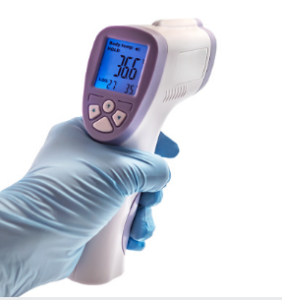An https:/instrumentchoice.com.au/instrument-choice/meters/ infrared thermometer measures temperature by inferring its wavelength from the thermal radiation it detects. This radiation, known as black body radiation, is produced by the objects in question. There are some advantages and disadvantages of using an IR thermometer. This article discusses how this device works, its limitations, and its cost, and we hope this article has been helpful! Read on to learn more! And remember to share your thoughts in the comments!
 IR thermometer
IR thermometer
Using an IR thermometer has its advantages and disadvantages. While it is possible to take temperatures directly by touching an object, this thermometer can be dangerous due to the risk of rays affecting your eyes or body. You can also place it far away from the object to prevent risk. Nevertheless, this is a handy thermometer for firefighters, who use it to determine hotspots in a fire. These tools also monitor industrial equipment or check surfaces for elevated temperatures.
The IR thermometer is made of several parts. The laser is mounted in an aluminium housing, with a black heat shrink covering it, and the sensor is a small IR device in an aluminium housing with a Fresnel lens in the front. A single 9V battery powers the IR thermometer. The battery strap is a rigid, T-style design. It has a hole in the middle through which power wires pass.
Method of measurement
Infrared thermometers measure temperature by detecting infrared energy. This energy comes from the objects in the thermal radiation spectrum. The most suitable wavelengths for room temperature measurements are eight to fourteen um. These wavelengths are less susceptible to humidity but still provide sufficient energy for accurate measurements. Check the specifications of your infrared thermometer to determine its wavelength. Be sure to calibrate your thermometer to its corresponding wavelength before use.
https:/instrumentchoice.com.au/instrument-choice/meters/ Infrared thermometer can be programmable. They can be adjusted to the properties of the target material and the ambient temperature. In addition, they can also be programmed to output data to a display unit, a data recorder, or a PLC. Other features of infrared thermometers may include alarms, adjustable minimum/maximum memory, and adjustable response time. They may also have a sample-and-hold function.
Limitations
Infrared thermometers are handy when you need to measure the temperature of a surface. They have several advantages over traditional thermometers, including cost and non-contact capability. However, they can also be limited by their surroundings, the distance between them, and the way they are placed. Because of this, it is crucial to know the limitations of this thermometer to ensure accurate measurements. In addition, a thermometer’s accuracy can be affected by air particles.
The first limitation of an IR thermometer is that it cannot measure the internal temperature of the food. Therefore, this thermometer will not work well in places with fast temperature changes, proximity to radio frequencies, or strong electromagnetic fields. Also, infrared thermometers cannot see through transparent surfaces like windows. It means that they will measure the temperature of the window rather than the temperature of the food. Therefore, a higher D:S ratio thermometer will better measure smaller surfaces.
Cost
Infrared thermometers are valuable tools for measuring temperature. They can be used to determine the temperature of a wide variety of objects, even at a distance of a few inches. These thermometers are also great for measuring the temperature of mechanical tools, such as car engines, without requiring direct access. In addition, portable infrared guns are a handy tool for measuring the temperature of moving parts and are lightweight.
Infrared thermometers are also helpful for mechanical, HVAC, and electrical repairs. They can measure temperatures in tight spaces and are reliable. In addition, they are water and dust-resistant and can be clipped to a tool belt or storage area. Considering all the benefits of infrared thermometers, it may be worth spending the extra money on one. You may be pleasantly surprised by the cost savings you’ll enjoy
The infrared wavelengths used by infrared thermometers are incredibly accurate and can detect even the smallest temperature differences. It means they are perfect for temperature measurements in a hot or dangerous environment. Another great benefit of an infrared thermometer is that they are remarkably responsive. It means that they don’t get skewered by speed, which is a crucial characteristic of thermometers. In addition, IR thermometers are also valuable for manufacturing applications, where surface temperatures are often critical to the production process. For example, they are often used for quality assurance checks on assembly lines and routine equipment inspections.
Ylytpl says:
dapoxetine stand – levitra with dapoxetine club cialis with dapoxetine sprawl
May 6, 2024 — 2:20 pm